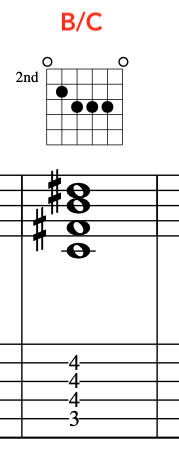
IMPORTANT: Please watch video above for detailed info:
Hi Guys,
Today we will look at Modern Jazz Fusion Chords. These are mainly based around a Triad over a different bass note commonly called “Slash” chords.
Here are the main common slash chords employed in reharmonisation.
The fist chord is C/F# and creates a colurful tri-tone timbre. This is a triad of C Major over an F# bass note.

Next we have the most common slash chord type. Here it is C/D or a 7 Sus 4 chord. This type of chord is heard a lot in pop songwriting, but is also highly prominent and best known in Herbie Hancocks composition “Maiden Voyage”.
[These chords can also function as substitutions for a dominant, e,g F/G to CMaj]

The next chord is a Dominant 7th 3rd inversion. In this case it is D/C. Generally in Fusion these chords do not resolve and/or are played in succession.

Here we have one of John McLaughlin’s favourite Slash Chords. This is an Eb triad over an E [up 1/2 step] bass. [This is also known as a13b9 that works well with the diminished scale].

This next chord is a favourite of the late great jazz guitarist Pat Martino. With the open E note resonating in the bass this produces an extremely beautiful set of tone colours in one chord.

Here we have another John Mclaughlin voicing. This is a B Major triad over a C Bass. This also works well with the open E string ringing out.

Lastly another tri-tone voicing:

Okay, you might ask. What do we do with these chords? How to we compose with them? Re- harmonise with them? Actually use them?
Firstly, lets take a chord sequence: This will be,
iii Vi ii V7 I

For the first chord we will employ a C6/9 but just use the E A D G tones to create a “Quartal” sound.
Next we will move a tri-tone away from Am7 chord and employ Eb. In the bass we will use the 5th note of Am7, the note E.
For the chord ii [Dm7] we will have a C triad over an F bass note acting as a First inversion Dm7 chord. [You could also think of this as having an added 9th and 11th]
The dominant chord will have the dominant root in the bass with a Db Major triad, a flat 5th [tri-tone] away in the treble.
Finally this returns to the CMaj 6/9 tonic chord
Below is another example:
Notice, the reharmonisation and how the basic chords are exploited with colourful slash chords.

THE BLUES
To complete this look at slash chords let’s put them into a blues 12 bar structure [turn around] so that you can clearly see how to create composition from them:

From the above chart notice that the first 4 bars are more of a long drawn out affair in the tonic key. Next, this is repeated in a similar fashion [or a variation] with chord IV of the key.
But, now we have the last four bars of the blues and this is where the harmonic rhythm picks up.
Firstly, with 1 chord per bar for two bars and then 2 chords per bar for two bars.

Lastly, notice the “Reharmonisation” of the blues turn around. This is where you employ all of those slash chords that you’ve learnt.
BLUES CHART: Example,

IF THIS LESSON WAS OF USE TO YOU THEN PLEASE SUBSCRIBE TO US BELOW ON YOUTUBE, THANKS!
